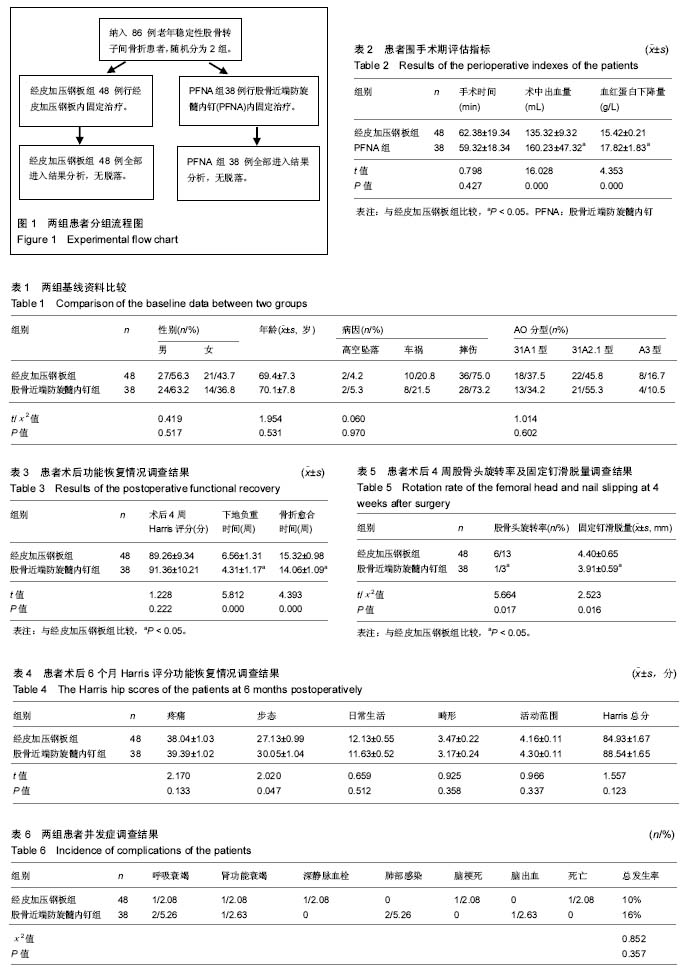| [1] 吴迪,张诗林,蔡楠,等.DHS和PFNA治疗老年骨质疏松性股骨粗隆间骨折的分析[J].中国老年学杂志,2015,35(23):6912-6913.[2] Nüchtern JV, Ruecker AH, Sellenschloh K, et al. Malpositioning of the lag screws by 1- or 2-screw nailing systems for pertrochanteric femoral fractures: A biomechanical comparison of gamma 3 and intertan.J Orthop Trauma. 2014;28(5):276-282.[3] Hsu CE, Chiu YC, Tsai SH, et al.Trochanter stabilising plate improves treatment outcomes in AO/OTA 31-A2 intertrochanteric fractures with critical thin femoral lateral walls.Injury. 2015;46(6):1047-1053.[4] 季英楠,阿良,赵忠海,等.骨折分型及外侧壁厚度对动力髋螺钉治疗外侧壁完整的股骨粗隆间骨折的影响[J].中国医科大学学报, 2015,44(9):818-821,825.[5] Mereddy P, Kamath S, Ramakrishnan M, et al. The AO/ASIF proximal femoral nail antirotation (PFNA): a new design for the treatment of unstable proximal femoral fractures. Injury. 2009;40(4): 428-432.[6] Guo Q, Shen Y, Zong Z, et al. Percutaneous compression plate versus proximal femoral nail anti-rotation in treating elderly patients with intertrochanteric fractures: A prospective randomized study. J Orthop Sci. 2013;18(6):977-986.[7] Goeden RD. Critique and revision of Harris' scoring system for selection of insect agents in biological control of weeds. Prot Ecol. 1983;5(4):287-301.[8] Gadegone WM, Ramteke AA, Lokhande V, et al.Valgus intertrochanteric osteotomy and fibular strut graft in the management of neglected femoral neck fracture.Injury. 2013;44(6):763-768.[9] Knobe M, Drescher W, Heussen N, et al. Is helical blade nailing superior to locked minimally invasive plating in unstable pertrochanteric fractures? Clin Orthop Relat Res. 2012;470(8):2302-2312. [10] Daltro GC, Fortuna V, Souza ESD, et al. Efficacy of autologous stem cell-based therapy for osteonecrosis of the femoral head in sickle cell disease: a five-year follow-up study. Stem Cell Res Ther. 2015; 6(1):110.[11] Santoni BG, Nayak AN, Cooper SA, et al. Comparison of Femoral Head Rotation and Varus Collapse Between a Single Lag Screw and Integrated Dual Screw Intertrochanteric Hip Fracture Fixation Device Using a Cadaveric Hemi-Pelvis Biomechanical Model. J Orthop Trauma. 2016;30(4):164.[12] Jameson SS, Mason JM, Baker PN, et al. No functional benefit of larger femoral heads and alternative bearings at 6 months following primary hip replacement. Acta Orthop. 2015;86(1):32-40.[13] He W, Zhang W. The Curative Effect Comparison Between Prolonged Third Generation of Gamma Nail and Prolonged Dynamic Hip Screw Internal Fixation in Treating Femoral Intertrochanteric Fracture and the Effect on Infection. Cell Biochem Biophys.2015;71(2):695-699.[14] 于永杰,杨东,焦兆德,等.股骨近端万向锁定钢板治疗老年股骨粗隆间骨折的效果观察[J].山东医药,2016,56(17):96-97.[15] Kim Y, Bahk WJ, Yoon YC, et al. Radiologic healing of lateral femoral wall fragments after intramedullary nail fixation for A3.3 intertrochanteric fractures. Arch Orthop Trauma Surg. 2015;135(10):1349-1356.[16] 薛金伟,戴富强,姜源涛,等.人工股骨头置换与防旋型股骨近端髓内钉治疗高龄稳定型股骨粗隆间骨折的疗效比较[J].中国老年学杂志,2016,36(2):401-403.[17] Shen J, Luo F, Sun D, et al.Mid-term results after treatment of intertrochanteric femoral fractures with percutaneous compression plate (PCCP).Injury. 2015;46(2):347-357.[18] 张志宏, 董恒纲, 李泽芹. 不同治疗方法对老年骨质疏松性股骨粗隆间骨折的疗效观察[J]. 中国骨质疏松杂志, 2012, 18(11): 1032-1035.[19] 沈波,焦竞,勘武生,等.人工关节置换与内固定术治疗老年股骨粗隆间骨折的Meta分析[J].华中科技大学学报(医学版),2014, 43(5):586-594.[20] Carvajal-Pedrosa C, Gómez-Sánchez RC, Hernández-Cortés P. Comparison of Outcomes of Intertrochanteric Fracture Fixation Using Percutaneous Compression Plate Between Stable and Unstable Fractures in the Elderly. J Orthop Trauma. 2016;30(6):201.[21] 马骁,焦福德,王志涛,等.PCCP与DHS治疗老年股骨粗隆间骨折的临床比较[J].中国老年学杂志,2016,36(10):2448-2449.[22] 谈中文.PFNA与PCCP治疗股骨粗隆间骨折的疗效比较[J].中南医学科学杂志,2016,44(1):57-58.[23] Zeng X, Zhang N, Zeng D, et al. Proximal femoral nail antirotation versus dynamic hip screw fixation for treatment of osteoporotic type 31-A1 intertrochanteric femoral fractures in elderly patients. J Int Med Res. 2017;45(3):1109-1123.[24] Shen J, Luo F, Sun D, et al. Mid-term results after treatment of intertrochanteric femoral fractures with percutaneous compression plate (PCCP).Injury. 2015;46(2):347-357.[25] Zhu F, Liu G, Shao H, et al. Treatment of Femoral Neck Fracture with Percutaneous Compression Plate: Preliminary Results in 74 Patients. Orthop Surg. 2015;7(2):132-137.[26] Crespo E, Gómez S, Palacios V, et al. Long-term results after treatment of pertrochanteric femoral fractures with percutaneous compression plate (PCCP).Eur J Orthop Surg Traumatol.2016;26(6):613-617.[27] 王亚梓,王蕾,张海牛,等.股骨转子间粉碎骨折:小转子必须固定吗[J].中华创伤骨科杂志,2004,6(9):970-971.[28] Hsueh KK,Fang CK,Chen CM,et al.Risk factor in sliding hip screw in intertrochanteric fractures:an evlution of 937 patients.Int Orthop. 2010;8:1273-2176.[29] Van ED, Stollenwerck GA, Koster LA, et al. The stability of fixation of proximal femoral fractures: a radiostereometric analysis. Bone Joint J. 2015;97-B(3):391-397.[30] Janssen SJ, Teunis T, Hornicek FJ, et al. Outcome after fixation of metastatic proximal femoral fractures: A systematic review of 40 studies. J Surg Oncol. 2016;114(4):507-519.[31] Zhang Y, Tian L, Yan Y, et al.Biomechanical evaluation of the expansive cannulated screw for fixation of femoral neck fractures. Injury. 2011;42(11): 1372-1376. |
.jpg)

.jpg)